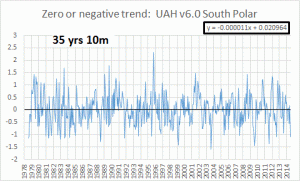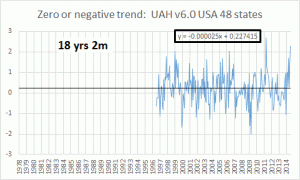With the release of June data, showing the marked impact of a moderately strong El Nino, using UAH v. 6.0 data I have calculated the longest period back that the length of the pause in tropospheric temperature has been less than +0.01 degrees Celsius per 100 years:
Globally:
North Polar:
Northern Hemisphere:
Tropics:
Southern Hemisphere:
South Polar:
Australia:
USA:
The El Nino will affect the length of the pause in some regions, but not all. The pause continues!








August 4, 2015 at 5:02 pm
Slightly OT Ken but looking at the BoM’s summaries for July, I notice that the Qld coastline from Gold Coast to Hervey Bay (District 40) is showing the max mean as above average. If you check the average means for each site, it is plain to see that the mean is below average by about 2 degrees.

Is this a problem with the homogenisation process?
July max temp anomaly Qld
Qld July summary
http://www.bom.gov.au/climate/current/month/qld/summary.shtml
August 4, 2015 at 6:44 pm
Hi ian. Haven’t checked. There may be a simple explanation but I’m always a bit sus- it has happened at other places and times.
August 7, 2015 at 7:35 am
Ian, Lance (Silliggy) knows a lot about these maps and should be able to help.
August 5, 2015 at 6:57 am
Sorry Ken – that should read District 40 below average (not 2C). Might send to the Qld Bureau to find out how they do the shading.
August 6, 2015 at 7:41 pm
As you can see here Ian I am seriously interested in these maps.
August 6, 2015 at 7:26 pm
Ian I checked a few by eye and could not see a problem. Did not have time to calculate the averages. Can you give an example of a site that is wrong rather than an area?
August 8, 2015 at 7:32 pm
[…] UAH-Daten nach Regionen: https://kenskingdom.wordpress.com/2015/07/09/pause-update/#comments […]
August 9, 2015 at 11:51 am
Ken I have sent this post to Bob Tisdale and asked why there is a no show of the “Super” el nino of 97-98 in the OZ and USA data? Can you offer an opinion? Also have you tried to graph RSS over this time period?
August 9, 2015 at 2:02 pm
Gday Neville
No I have not tried RSS. El Ninos have varying effects in Australia, depending on what is happening in the Indian Ocean. The Indian Ocean Dipole, IOD, has a marked effect on rainfall from the northwest to the south east of Australia, and consequently temperatures. This can accentuate of minimise El Nino effects, as appears to be the case this year.
August 9, 2015 at 4:49 pm
Thanks for that Ken. BTW Bob Tisdale responded to my inquiry as well.
Bob Tisdale says:
August 8, 2015 at 10:19 pm
Neville says: “Also why is the “super” el nino of 1997-8 not noticeable in the Australian and USA graphs?”
The responses of both subsets to the 1997/98 El Nino are masked by the monthly weather noise. Smooth both with 12-month filters and you’ll see the responses.
Cheers.
August 10, 2015 at 4:01 am
Reblogged this on wobleibtdieglobaleerwaermung and commented:
Mit den Juni Daten, die bereits den sichtbaren globalen Erwärmungseffekt von kräftigen El Nino-Bedingungen zeigen, hat der australische Blogger Ken Steward die UAHv6-Daten verschiedener Regionen der Erde bis zu dem Punkt zurückgerechnet, die die längste Periode mit einer “Erwärmungspause” mit wenigewr als 0,1°C in 100 Jahren ergeben. Betrachtesnwert und erstaunlich!